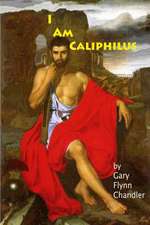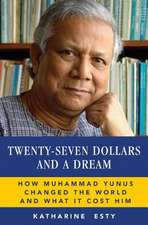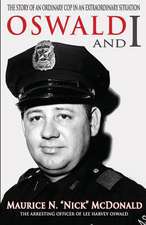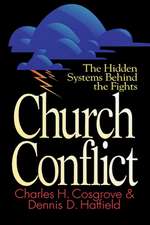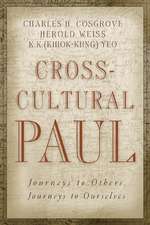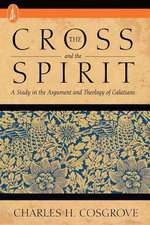Fortune and Faith in Old Chicago: A Dual Biography of Mayor Augustus Garrett and Seminary Founder Eliza Clark Garrett
Autor Charles H. Cosgroveen Limba Engleză Hardback – 24 feb 2020
This engaging biography of Augustus Garrett and Eliza Clark Garrett tells two equally compelling stories: an ambitious man’s struggle to succeed and the remarkable spiritual journey of a woman attempting to overcome tragedy. By contextualizing the couple’s lives within the rich social, political, business, and religious milieu of Chicago’s early urbanization, author Charles H. Cosgrove fills a gap in the history of the city in the mid-nineteenth century.
The Garretts moved from the Hudson River Valley to a nascent Chicago, where Augustus made his fortune in the land boom as an auctioneer and speculator. A mayor during the city’s formative period, Augustus was at the center of the first mayoral election scandal in Chicago. To save his honor, he resigned dramatically and found vindication in his reelection the following year. His story reveals much about the inner workings of Chicago politics and business in the antebellum era.
The couple had lost three young children to disease, and Eliza arrived in Chicago with deep emotional scars. Her journey exemplifies the struggles of sincere, pious women to come to terms with tragedy in an age when most people attributed unhappy events to divine punishment. Following Augustus’s premature death, Eliza developed plans to devote her estate to founding a women’s college and a school for ministerial training, and in 1853 she endowed a Methodist theological school, the Garrett Biblical Institute (now the Garrett-Evangelical Theological Seminary), thereby becoming the first woman in North America to found an institution of higher learning.
In addition to illuminating our understanding of Chicago from the 1830s to the 1850s, Fortune and Faith in Old Chicago explores American religious history, particularly Presbyterianism and Methodism, and its attention to gender shows how men and women experienced the same era in vastly different ways. The result is a rare, fascinating glimpse into old Chicago through the eyes of two of its important early residents.
The Garretts moved from the Hudson River Valley to a nascent Chicago, where Augustus made his fortune in the land boom as an auctioneer and speculator. A mayor during the city’s formative period, Augustus was at the center of the first mayoral election scandal in Chicago. To save his honor, he resigned dramatically and found vindication in his reelection the following year. His story reveals much about the inner workings of Chicago politics and business in the antebellum era.
The couple had lost three young children to disease, and Eliza arrived in Chicago with deep emotional scars. Her journey exemplifies the struggles of sincere, pious women to come to terms with tragedy in an age when most people attributed unhappy events to divine punishment. Following Augustus’s premature death, Eliza developed plans to devote her estate to founding a women’s college and a school for ministerial training, and in 1853 she endowed a Methodist theological school, the Garrett Biblical Institute (now the Garrett-Evangelical Theological Seminary), thereby becoming the first woman in North America to found an institution of higher learning.
In addition to illuminating our understanding of Chicago from the 1830s to the 1850s, Fortune and Faith in Old Chicago explores American religious history, particularly Presbyterianism and Methodism, and its attention to gender shows how men and women experienced the same era in vastly different ways. The result is a rare, fascinating glimpse into old Chicago through the eyes of two of its important early residents.
Preț: 182.12 lei
Nou
Puncte Express: 273
Preț estimativ în valută:
34.85€ • 36.01$ • 29.01£
34.85€ • 36.01$ • 29.01£
Carte disponibilă
Livrare economică 04-18 martie
Livrare express 15-21 februarie pentru 42.74 lei
Preluare comenzi: 021 569.72.76
Specificații
ISBN-13: 9780809337941
ISBN-10: 0809337940
Pagini: 320
Ilustrații: 32
Dimensiuni: 152 x 229 x 33 mm
Greutate: 0.63 kg
Ediția:1st Edition
Editura: Southern Illinois University Press
Colecția Southern Illinois University Press
ISBN-10: 0809337940
Pagini: 320
Ilustrații: 32
Dimensiuni: 152 x 229 x 33 mm
Greutate: 0.63 kg
Ediția:1st Edition
Editura: Southern Illinois University Press
Colecția Southern Illinois University Press
Notă biografică
Charles H. Cosgrove is a professor of early Christian literature and the director of the PhD program at Garrett-Evangelical Theological Seminary, a union of schools descended from the institution founded by Eliza Garrett in 1853 and located on the campus of Northwestern University. He is the author of numerous books and articles in a wide range of fields, including theology, ethics, ancient music, and legal history. A lifelong native of the Chicago area, he is an aficionado of the city’s history and makes the occasional appearance in area music venues as a professional jazz trombonist.
Extras
PROLOGUE
This is the story of two adventurous people of the postrevolutionary generation. Augustus and Eliza (née Clark) Garrett met and married in the Hudson Valley village of their youth. Eager to escape farm life, they headed west, lured by rumors of great opportunities in Cincinnati. Unsuccessful there, they went on to New Orleans, then Natchitoches, and finally, all but completely disheartened by failure and personal tragedy, they risked their futures on a remote trading post called “Chicago” near the sleepy mouth of a prairie river.
Augustus amassed great wealth in Chicago, first as an auctioneer during the great land speculation of 1835, then as an investor in real estate and a commission agent for firms trading in goods between New York City and Chicago. He also served twice as mayor of Chicago. In the decades preceding the Civil War and before the rise of professional machine politics, he was among the handful of leading businessmen who took turns running the city as aldermen and chief executives, men who converted the “little log and clapboard village” into a booming commercial center.
Only two of these early Chicago leaders have been treated in full biographies—John Wentworth, who also served as a congressman of the Fourth Congressional District of Illinois, and William B. Ogden, the city’s first mayor, who was one of its most important developers as well as a pioneer in railroads. As for the other mayors and influential citizens of the city’s early years—men such as Walter Newberry, Thomas Dyer, Benjamin Raymond, and Ira Miltimore—one finds at most only a handful of paragraphs devoted to this one or that, and almost nothing about the city’s women. Primary sources are scarce, due in part to the destruction of so many personal and public papers in the Great Chicago Fire of 1871 but also to the failure of most families to preserve or send off to archives the relics of ancestors who had shaped the history and institutions of the city. As for the contributions of women in particular, antebellum culture accorded women little place in public life. Their names and doings seldom appeared in the Chicago newspapers, and rarely was the correspondence of a woman preserved by her family or a library. As a result, even the most remarkable women of early Chicago are practically unknown.
Eliza Garrett was one such woman. In most ways a dutiful nineteenth- century wife with little say or influence, limited in decision-making power even in her own home, she came into her own when her husband died, suddenly, in his forty-seventh year. This event made her something of a rarity in antebellum America—an independently wealthy woman. To preserve her inheritance, she gave up her house and lived like a church mouse, spending the next several years involved in various causes, including raising money for a preparatory school for the new Northwestern University and making plans to establish a “female college.” In the end, Eliza decided to endow both a theological school and a women’s college. Due to a contingency in the funding, the latter institution did not materialize; but the theological school was established, making Eliza the first woman in North America to found an institution of higher learning.
The chapters to follow trace the lives of the Garretts from their court-ship days in rural New York to their lives as public citizens in the fast-developing city of Chicago, where fortunes were made in the wake of Indian “removal,” land speculators turned a frontier outpost into a metropolis, boosters bet that a canal would make Chicago the great commercial hub between the Eastern Seaboard and the Gulf of Mexico, citizen politicians managed city affairs in their spare time, and women struggled to have a say in more than household routines and tea parties. Augustus Garrett was a speculator, canal booster, and citizen-politician who made a name and a fortune for himself in the heady days of the young and rising city. Eliza Garrett was the wife who emerged from his shadow to make her own mark on history by giving away his estate.
Chapter 1.
Newburgh Beginnings
Newburgh Beginnings
Henry Hudson was probably the first European to visit Newburgh bay. In mid-September of 1609 his sailing ship, the Half Moon, making its way up the river that natives of the region called “Muhheakunnuk” and whites would eventually name “Hudson,” paused in a small apron of the stream. There his navigator set down a brief description, remarking that it was “a very pleasant place to build a town on.” A historian later imagined the scene more picturesquely—“sun streaming down on the over-hanging Highlands and the magnificent virgin forests which clothed the riverbanks with their gorgeous autumnal hues.” Two hundred years after Hudson’s visit to the spot, this bay was the main port for Newburgh (then written New Burgh). A town covering some thirty square miles was officially organized in 1788, and a village, huddled around the bay, was carved out of the town through legal incorporation in 1800—its chief claim to fame being that it had recently served as headquarters for Washington’s Continental Army in the Revolutionary War.
Leaving Newburgh on the North Road, one passed through the districts of north Orange County, where farmlands sloped rather steeply toward the Hudson River. Here stony fields struggled to produce barley and wheat, oats and peas; orchard trees sent their roots deep and wide to nourish the apples, pears, plums, and peaches that must fill the larder and the jar. There were sheep, hogs, and cows in pens and small barns, too, all for home consumption, not sale on the market. Yet here and there one spied bits of industry—the occasional brewery, gristmill, tannery, brick factory, and sawmill by which farming men tried to improve their lot. In Middle Hope of this district, north of Balmville, Augustus Garrett and Eliza Clark grew up.
By the 1830s Middle Hope was a respectable hamlet consisting of a post office, two taverns, a school, a Methodist chapel, and a dozen houses. But when Eliza was born there on March 5, 1805, Middle Hope was a mere crossroads. Her parents’ farm lay off the main road and somewhat to the of Middle Hope, close to the county border. A mile or two farther on, in the little town of Marlborough in Ulster County, was a Presbyterian church. To this church, which stood on a bluff near the Hudson River, the Clark family journeyed most Sundays.
She was the daughter of Benoni and Amy (Demott) Clark. Benoni’s mother, Joanna Clark, was from Cornwall. For reasons not disclosed in the records, Benoni was adopted by his grandfather, Nathan Clark Jr., and for that reason carried the Clark surname. There may be a clue in the name “Benoni,” a biblical word meaning “son of my sorrow.” It appears with some frequency in the genealogies of New Englanders of the seventeenth and eighteenth centuries, more often than not as the name of children born under unfortunate circumstances—the death of the mother in childbirth, the death of the father before the birth of the child, a birth out of wedlock, or the death of the child soon after birth. Little is known of Benoni’s parents, but it is possible that Joanna bore Benoni out of wedlock. This would explain why he carried the Clark surname. Joanna Clark eventually married a man named Samuel Stratton.
Benoni, born in 1760, turned fifteen at the start of the Revolutionary War. No record indicates whether he served in any branch of the Continental Army, but he is listed as an ensign in an Orange County regiment of the New York militia in 1805 under Colonel Leonard Smith. Sometime after the war he married Amy Demott of nearby Balmville. They had five children, all born in Newburgh Township: Samuel, Isaac, Jeremiah, John, and Eliza.
Amy Demott’s lineage is somewhat cloudy. She was a granddaughter of Michael Demott and the daughter of either Isaac or James Demott, both of whom served in the Revolutionary War under a Samuel Clark. In the mid-eighteenth century, Michael Demott owned land in Balmville and kept a small tavern there. In 1786 Isaac and James were each granted parts of some four hundred forested acres of the German patent in Balmville.
Balmville took its name from a tree, which stood beside the North Road on Isaac’s property, west of his father’s tavern. The tree was an eastern cottonwood that locals mistakenly identified as a species of poplar known as balm of Gilead. Various legends were passed down about the origin and antiquity of the Balmville tree. Science, however, would eventually establish that the tree—at least the one well known as “the Balmville tree” in the early nineteenth century—began growing in 1699. By the time Eliza came along a hundred years later, everyone knew the tree on her maternal family’s land. It was thought to have medicinal properties, and its fame made it a destination for locals and villagers on Sunday walks. One can picture the Demott family picnicking there in the 1820s with Augustus Garrett the suitor on hand, full of mirth as he tried to charm his way into the family.
Almost everyone in the districts outside Newburgh Village farmed, despite the poor conditions for cultivation. The average family produced little for outside sale, and there was little market for cash crops anyway. This made it difficult for a man to make a profit in hopes of increasing his landholdings or even making the transition from renting to owning. By 1800, when Benoni was forty years old, he still owned no land and possessed personal property valued at only $250.
To understand Eliza, it is necessary to see her first in the world of her childhood and adolescence. Farm life affected women of the early 1800s in different ways. In Eliza’s case, rural living placed frustrating limits on her cultural experience but also hardened her to plain living. As a result, she was eager to fly away to far-off cities with Augustus but also accepting of the hardships that went with his failures in those places.
[end of excerpt]
Cuprins
Contents
List of Illustrations
A Note to the Reader
Prologue
1. Newburgh Beginnings
2. Prosecuted and Put to Cost
3. The Great Fairy Land of Fortunes
4. Crash and Conversion
5. The Politician
6. Their Separate Spheres
7. The Founder
Postscript
Acknowledgments
Notes
Bibliography
Index
List of Illustrations
A Note to the Reader
Prologue
1. Newburgh Beginnings
2. Prosecuted and Put to Cost
3. The Great Fairy Land of Fortunes
4. Crash and Conversion
5. The Politician
6. Their Separate Spheres
7. The Founder
Postscript
Acknowledgments
Notes
Bibliography
Index
Recenzii
“In telling the story of Augustus and Eliza Garrett, Charles H. Cosgrove has done an excellent job pulling together the slender threads of antebellum Chicago history. More than just a biography of an early mayor and businessman, this history illuminates the importance of evangelical religion in the social and cultural life of early Chicago."—Theodore J. Karamanski, author of Rally 'Round the Flag: Chicago and the Civil War
“Cosgrove focuses on two individuals who shaped and reshaped the diverse worlds of nineteenth-century Chicago political, religious, business, and educational life. Readable, enlightening, engaging, and instructive, the dual biography invites the reader into the fabric and feel of early nineteenth-century urban life. [Many] will appreciate greatly the careful attention to Eliza Garrett’s role in the founding of the institution that bears her name and her struggles with controlling clergy.”—Russell E. Richey, coauthor of The Methodist Experience in America: A Sourcebook
“Grounded in the development of Protestantism in Chicago and especially in the crucial role that Eliza Garrett played in founding Methodist institutions, this thoughtful look at an early Chicago couple who found economic success in the city's rise reminds us of just how many stories of early Chicago are yet to be told."—Ann Durkin Keating, author of The World of Juliette Kinzie: Chicago before the Fire
“Cosgrove captures the personal, economic, and religious struggles of a unique nineteenth-century American couple. Steeped in original research, Cosgrove’s book not only brings the sights and sounds of Old Chicago back to life but also allows us to see how the Garretts formed a unique partnership, leading one to a career in early Chicago politics and the other to become the first woman in the United States to found a theological seminary.”—Christopher H. Evans, author of The Social Gospel in American Religion: A History
“What stands out in this richly textured dual biography of Augustus Garrett, the seventh mayor of Chicago (1843–1844 and 1845–1846) and his determined, albeit emotionally scarred and religiously conflicted wife, Eliza Clark Garrett (founder of the Garrett Biblical Institute for the training of Methodist ministers, now the Garrett-Evangelical Theological Seminary on the Evanston campus of Northwestern University) is the illuminating glimpse into Chicago’s frontier past. The book is spiced with colorful anecdotes and forgotten facts.”—Richard C. Lindberg, Journal of the Illinois State Historical Society
“Cosgrove focuses on two individuals who shaped and reshaped the diverse worlds of nineteenth-century Chicago political, religious, business, and educational life. Readable, enlightening, engaging, and instructive, the dual biography invites the reader into the fabric and feel of early nineteenth-century urban life. [Many] will appreciate greatly the careful attention to Eliza Garrett’s role in the founding of the institution that bears her name and her struggles with controlling clergy.”—Russell E. Richey, coauthor of The Methodist Experience in America: A Sourcebook
“Grounded in the development of Protestantism in Chicago and especially in the crucial role that Eliza Garrett played in founding Methodist institutions, this thoughtful look at an early Chicago couple who found economic success in the city's rise reminds us of just how many stories of early Chicago are yet to be told."—Ann Durkin Keating, author of The World of Juliette Kinzie: Chicago before the Fire
“Cosgrove captures the personal, economic, and religious struggles of a unique nineteenth-century American couple. Steeped in original research, Cosgrove’s book not only brings the sights and sounds of Old Chicago back to life but also allows us to see how the Garretts formed a unique partnership, leading one to a career in early Chicago politics and the other to become the first woman in the United States to found a theological seminary.”—Christopher H. Evans, author of The Social Gospel in American Religion: A History
“What stands out in this richly textured dual biography of Augustus Garrett, the seventh mayor of Chicago (1843–1844 and 1845–1846) and his determined, albeit emotionally scarred and religiously conflicted wife, Eliza Clark Garrett (founder of the Garrett Biblical Institute for the training of Methodist ministers, now the Garrett-Evangelical Theological Seminary on the Evanston campus of Northwestern University) is the illuminating glimpse into Chicago’s frontier past. The book is spiced with colorful anecdotes and forgotten facts.”—Richard C. Lindberg, Journal of the Illinois State Historical Society
Descriere
This engaging biography of Augustus Garrett and Eliza Clark Garrett tells two equally compelling stories: an ambitious man’s struggle to succeed and the remarkable spiritual journey of a woman attempting to overcome tragedy. By contextualizing the couple’s lives within the rich social, political, business, and religious milieu of Chicago’s early urbanization, author Charles H. Cosgrove fills a gap in the history of the city in the mid-nineteenth century.



